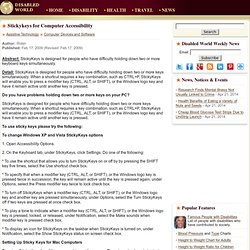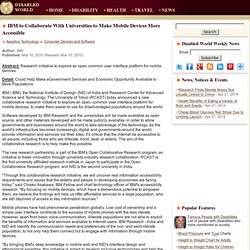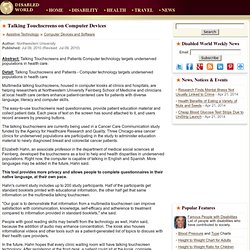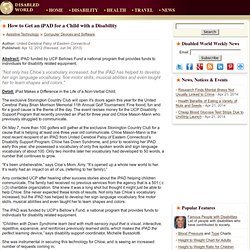

Assistive Technology 2.0: Special Tech.
Stickykeys for Computer Accessibility. Abstract: StickyKeys is designed for people who have difficulty holding down two or more keyboard keys simultaneously.

Detail: StickyKeys is designed for people who have difficulty holding down two or more keys simultaneously. When a shortcut requires a key combination, such as CTRL+P, StickyKeys will enable you to press a modifier key (CTRL, ALT, or SHIFT), or the Windows logo key and have it remain active until another key is pressed.
Intellectual/Learning. HCI and Aging Population. IBM to Collaborate With Universities to Make Mobile Devices More Accessible. Abstract: Research initiative to explore an open common user interface platform for mobile devices.

Detail: Could Help Make eGovernment Services and Economic Opportunity Available to More Populations IBM ( IBM), the National Institute of Design (NID) of India and Research Center for Advanced Science and Technology, The University of Tokyo (RCAST) today announced a new collaborative research initiative to explore an open, common user interface platform for mobile devices, to make them easier to use for disadvantaged populations around the world. Software developed by IBM Research and the universities will be made available as open source, and other materials developed will be made publicly available, in order to allow governments and businesses around the world to take advantage of the technology.
The new research partnership is part of the IBM's Open Collaborative Research program, an initiative to foster innovation through university-industry research collaboration. Wireless Association® to Focus on Accessibility and Disability Issues. Author: CTIA-The Wireless AssociationPublished: Jul 09, 2010 (Revised: Jul 09, 2010) Abstract: The wireless industry has a long history of developing and supporting services for the disabled community.

Detail: CTIA-The Wireless Association® to Focus on Accessibility and Disability Issues in July Edition of 'Wonder of Wireless' and Blog To Honor the 20th Anniversary of the Americans with Disabilities Act Throughout the Month. CTIA-The Wireless Association® and the wireless industry have been leaders in driving an ever-growing range of choices and opportunities for all consumers, including persons with disabilities, because wireless devices are uniquely positioned to meet these needs. In honor of the 20th Anniversary of the Americans with Disabilities Act, CTIA has dedicated the July edition of "Wonder of Wireless" (WOW) webcast and our blog (www.ctia.org/blog) to focus on accessibility and disability issues. To watch the July WOW webcast, please visit:
Talking Touchscreens on Computer Devices. Abstract: Talking Touchscreens and Patients Computer technology targets underserved populations in health care.

Detail: Talking Touchscreens and Patients - Computer technology targets underserved populations in health care Multimedia talking touchscreens, housed in computer kiosks at clinics and hospitals, are helping researchers at Northwestern University Feinberg School of Medicine and clinicians at local health care centers enhance patient-centered care for patients with diverse language, literacy and computer skills. The easy-to-use touchscreens read questionnaires, provide patient education material and collect patient data. Each piece of text on the screen has sound attached to it, and users record answers by pressing buttons. The talking touchscreens are currently being used in a Cancer Care Communication study funded by the Agency for Healthcare Research and Quality.
Hahn's current study includes up to 200 study participants. Related Topics Discuss this Document Cite This Document. Co:Writer University Edition Writing Tool Helps College Students with Disabilities. Abstract: Word prediction writing tool accommodates individuals with writing disorders and physical disabilities.

Detail: NEW Co:Writer(R) University Edition Writing Tool Helps College Students with Disabilities Express Clear Thoughts; Write with Proper Spelling and Grammar. Word prediction writing tool accommodates individuals with writing disorders and physical disabilities. Specifically designed to support postsecondary students in writing assignments. Works in all common writing applications and includes hundreds of topic dictionaries. Don Johnston just announced its new Co:Writer University Edition writing tool at the AHEAD Conference in Denver, Colorado.
Taking Brain Computer Interfaces to the Next Level. Author: Ecole Polytechnique Fédérale de LausannePublished: Feb 17, 2011 (Revised: Feb 17, 2011) Abstract: Shared Control approach to facilitating human-robot interactions employs image sensors and image-processing to avoid obstacles.

Detail: Brain-machine interfaces make gains by learning about their users, letting them rest, and allowing for multitasking. You may have heard of virtual keyboards controlled by thought, brain-powered wheelchairs, and neuro-prosthetic limbs. But powering these machines can be downright tiring, a fact that prevents the technology from being of much use to people with disabilities, among others. Professor José del R. In a typical brain-computer interface (BCI) set-up, users can send one of three commands – left, right, or no-command.
Human Cues to Improve Computer User Friendliness. Abstract: Research in computer graphics and computer vision tries to make using computers easier.

Detail: Lijun Yin wants computers to understand inputs from humans that go beyond the traditional keyboard and mouse. "Our research in computer graphics and computer vision tries to make using computers easier," says the Binghamton University computer scientist. "Can we find a more comfortable, intuitive and intelligent way to use the computer? It should feel like you're talking to a friend. This could also help disabled people use computers the way everyone else does. " The Role of Assistive Computer Technology.
People with Disabilities, Jobs and Technological Accessibility in America. Abstract: Some of todays technologies enable us to interact with each other on business levels despite a persons disability.

Detail: Americans, as well as everyone else around planet Earth, have a variety of technologies available to them at low or no cost that enable us to interact with one another in many ways. Some of these technologies enable us to interact with each other on business levels, despite a person's disability. These technologies include operating systems, office packages, phone service, and much more. The Ubuntu Operating System and Accessibility Features The Ubuntu Operating System is free of charge for anyone at all to download from the Internet, burn to a CD or DVD, and use.
Ubuntu has a built-in screen reader named, 'Orca,' that is flexible and uses various combinations of speech synthesis. Orca uses Braille, as well as magnification, and helps to provide access to applications and toolkits that support the AT-SPI or Gnome desktop. Ubuntu - www.ubuntu.com Related Topics. Apple iPad 2 Accessibility Features Review.
Abstract: A review of the new Apple iPad 2 accessibility features for visually impaired and persons with disabilities.

"The same VoiceOver screen reader available on the Apple iPhone also comes standard on the iPad 2. " Detail: The iPad2 is produced by Apple Inc. and started to be sold in the United States on March, 25th, 2011. The original iPad version 1 came equipped with some convenient accessibility features for persons with disabilities, the iPad 2 has expanded on those features. The iPad 2 is a tablet computer meaning that rather than having a traditional laptop with a screen and a keyboard, you just have a touch screen, to navigate you simply touch the screen.
The iPad 2 is a little different to the first iPad version.
How to Get an iPAD for a Child with a Disability. Author: United Cerebral Palsy of Eastern ConnecticutPublished: Apr 12, 2012 (Revised: Jun 04, 2013) Abstract: iPAD funded by UCP Bellows Fund a national program that provides funds to individuals for disability related equipment.

"Not only has Chloe’s vocabulary increased, but the iPAD has helped to develop her sign language vocabulary, fine motor skills, musical abilities and even taught her to learn shapes and colors. " Detail: iPad Makes a Difference in the Life of a Non-Verbal Child. The exclusive Stonington Country Club will open it's doors again this year for the United Cerebral Palsy Brian Morrison Memorial 11th Annual Golf Tournament.
Fine foood, fun and for a good cause is the theme of the day. On May 7, more than 100 golfers will gather at the exclusive Stonington Country Club for a cause that is helping at least one three year old communicate. “It’s been unbelievable,” says Cloe’s Mom, Amy. “Time is of the essence with language. Essential Accessibility - Tools for Website Accessibility.
Visually Impaired.